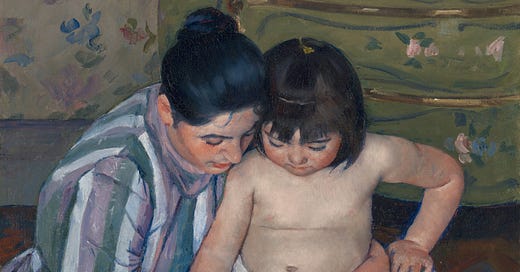I am the Asian Mom
How a Chinese dinner helped me realize I am playing the greatest role of my life.
The Child’s Bath, 1893, Mary Cassatt (American, 1844–1926) | The Child’s Bath is a tender portrayal of familial closeness, a subject that Mary Cassatt explored throughout her career. The caregiver’s cheek brushing the child’s shoulder, her encircling embrace, and the child’s pudgy hand on her knee suggest an emotional bond between the two.
Last night I took my son to a special Chinese dinner at Valley, a Sonoma-based restaurant with great food and chill vibes. The dinner was a takeover led by Coral Wang, a born-and bred New Yorker who’d spent time WOOFing through Europe, learning to make wine before arriving in Sonoma to start her own brand, Maison des Plaisances. Coral’s mother had flown out from New York to show Valley’s kitchen staff how to make her Chinese and Taiwanese dishes.
The evening was meant as both a celebration of her wine and to spark conversation about the little-known history of Chinese laborers in Sonoma.
Locals sometimes complain that there isn’t a great Chinese restaurant in town, though I’m wary of how that statement places judgement on the handful of Chinese and Asian restaurants and businesses here. Sonoma is not a big city, and The AAPI population makes up just 5% of the entire county. There aren’t any Chinese restaurants that serve up liang mien or hargow, which is typically what I think people mean when they say they want something “authentic,” (the word implied in the quest for “good Chinese,” but I will save my opinion about that for another newsletter installment.)
There is no Xi’An Famous Foods or Golden Unicorn in Sonoma. Many of the restaurants cater to tourists who come in search of dishes that celebrate the local agriculture and what Alice Waters coined “California cuisine.” This is why Coral’s takeover was extra special.
The evening was meant as both a celebration of her wine and to spark conversation about the little-known history of Chinese laborers in Sonoma. Amid the candlelit tables filling up with sticky rice, roast duck, and wontons, Coral placed maps and literature about the first Chinese laborers who’d built the very building that houses Valley. She shared archival pictures of the Sonoma Plaza with labels where Chinese laundromats and other businesses once lined the streets.
Coral’s intentions behind her dinner cast the concept of California cuisine in a completely new, and much-needed light. Food is history, and for Asian Americans who are a diverse group those histories connect us to the various policies that shaped our family stories of migration, assimilation, and belonging.
In addition to making wine, Coral is also part of a growing group of highly educated women farmers in Sonoma County. A 2019 report showed that 100% of CSA farms in Sonoma are co-owned by women for example. Empowering women and people of color in this field to share their stories can contribute to making California cuisine more equitable at and beyond the dinner table.
It occurred to me that Coral’s takeover at Valley was much bigger than a meal.
That night Coral greeted us upon arrival, and engaged my son in a delightful exchange about our Chinese heritage. We ordered her mother’s Taiwanese popcorn chicken, wontons, sweet sticky rice, and lotus root. As my son savored each bite I realized how much these flavor profiles bridged a connection between the two of us. We talked about the texture of the lotus and the chicken, how the food was seasoned with our favorite spices, and how much we cherish our heritage.
Our conversation helped me realize that Coral’s takeover at Valley was much bigger than a meal. It was part of what the novelist Ella King calls, “a movement toward a new canon of stories about motherhood in all its diversity, all its failures and triumphs.”
In truth, when we moved to Sonoma in 2021, I was very nervous about what it meant to raise my family in a town that is seemingly, predominantly white. I’ve since learned I was only looking at the surface of the city, through the eyes of a tourist that I no longer am. In fact I had taken us to Valley because my dear friend Rayna told me about it. I have assimilated into life here, and in the process have found my community and a stronger sense of myself. In true Asian Mom fashion, I let my son eat everything on the table except for a piece of popcorn chicken that had fallen on the floor. That floor chicken was my dinner because he was. so hungry.
I told my boy that the dinner was the best night of my life, to which corrected me. It was the second best. The best night of my life was the night he was born.
I realized that I am his connection to our heritage. In that moment I felt a great relief and even greater responsibility.
For us half asians and first generation Asian Americans, there’s often a concern that the connection we have to our culture begins and ends with our own mothers. “Am I even Korean anymore if there's no one left to call and ask which brand of seaweed we used to buy?” writes Michelle Zauner in Crying in H Mart.
That night at dinner I realized that I — in all my incompleteness — am his connection to our heritage. In that moment I felt a great sense of relief and even greater sense of responsibility.





